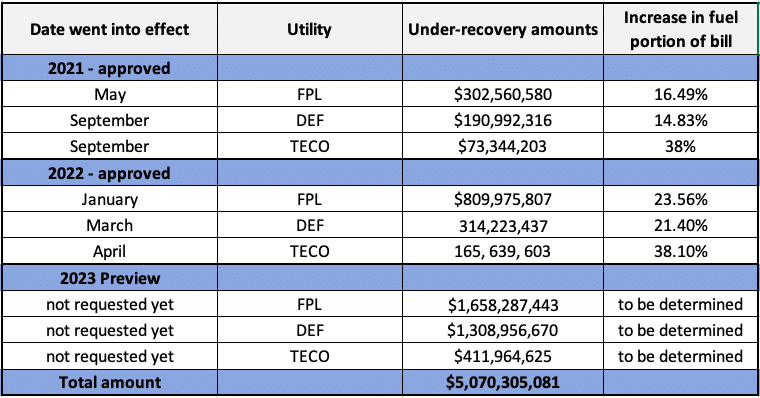Florida power bills are spiking (again!) - due primarily to high fossil gas prices. The state's reliance on fossil gas is pummeling hard working families and businesses. It's time for state regulators to help get customers off the high-bill treadmill.
George Cavros | September 8, 2022 | Energy Efficiency, Florida, Fossil GasIf you’re a Florida electricity customer, brace yourself, your power bill is set to spike again. The culprit is the Florida utilities’ reliance on fossil gas (also referred to as natural gas) and the high market price of the fuel, and there’s no end in sight in the near term. In a blog posted last year, we flagged the financial risk of the state’s high reliance on fossil gas. Since then, the price of fossil gas has continued to climb – as have power bills. It’s time for the state to prioritize low cost, lost risk resources – like using energy smarter.
The requested bill increases for next year
A few days ago, Florida’s three biggest investor-owned utilities (Florida Power and Light, Duke Energy Florida, and Tampa Electric Company) filed their projected fuel costs for next year. The filings are part of an annual fuel clause docket at the Florida Public Service Commission (PSC) – the agency that regulates that states biggest power companies. A hearing is set for November 1st to consider the requested fuel charges, and if approved, they will go into effect in January 2023.
The utilities use a customer usage benchmark of 1,000 kWh per month to project bill impacts. See the impact of the requested fuel increases below based on that benchmark. The utilities charge a higher fuel rate for customers that use more than 1,000 kWh of power per month. So, if you use more, you’ll pay a higher fuel rate and a higher bill.

The table only captures impacts from higher projected fuel costs. The utilities are also carrying out multiyear plans, approved in 2021, that include increasing base electric rates, and include other charges on bills, such as higher storm protection plan costs. According to the utilities’ filings (Schedule E-10), the total bills projected for 2023 are as follows:
- Florida Power and Light says its customers historically served by FPL will pay $130.23, up from $120.67 this year.
- In the NW Florida areas formerly served by Gulf Power, customers will pay $160.43 in 2023, up from $155.61.
- Duke Energy Florida says its customers will pay $170.68 in 2023, up from $148.23 this year.
- Tampa Electric says its customers would pay $146.86 in 2023, up from $132.66 this year.
But wait, unfortunately there’s more
For the last several years, the utilities’ fuel price projections have come-in too low. That leaves them paying more for fuel than they are recovering from customers. Therefore, in 2021, and earlier this year, they came to the Commission for “mid-course” corrections that allow them to adjust the fuel portion of your bill to recover their extra fuel costs prior to the end of the year. The utilities can also tack on the under-recovery to the fuel portion of your bill for the following year.
These same utilities under-recovered fuel costs for the latter part of this year as well; but they are opting not to pass on those additional fuel costs onto customers yet, instead waiting for later this year or early next year to file for those bill increases. The result is that customers will get a double-hit in 2023 – with the bigger fuel hit likely coming later in the year.
Presumably, the companies are trying to mitigate the price shock to customers because the latest under-recovery for 2022 is massive and will significantly spike bills. (Note: this bill hit is likely understated as fossil gas prices have continued to climb). For those of you that have not been able to track the previous two approved mid-course corrections, or the one to be filed soon, we’ve provided a table below.

The previously approved mid-course corrections, along with the ones that will be filed soon, will have cost Florida’s families and business cumulatively over $5 billion since 2021. By any standard, that’s a huge transfer of wealth from Floridians’ wallets to out-of-state fossil fuel interests.
While state regulators and utilities can’t control the price of fossil gas – they can ensure that investments in low cost, low risk renewables and energy efficiency are prioritized. To their credit, Florida utilities have been ramping up solar development to reduce their reliance on fossil fuels, but much more needs to be done on managing electricity demand by helping customers reduce energy use and save money on bills.
Getting customers off the high bill treadmill
Floridians pay some of the highest electricity bills in the country. That’s due in part to Florida being one of the worst states in the nation in capturing energy savings for customers through utility-led energy efficiency programs. Utility investment in energy efficiency can help get customers off of the high bill treadmill in two ways. First, energy efficiency helps reduce customer power demand which leads to less fossil gas burned to generate electricity – lowering bills for all customers. Secondly, energy efficiency programs help customers reduce energy use and save money on bills – this is particularly critical to energy-burdened customers.
So, what’s holding us back?
Florida uses practices dating back to the early 90s to set its energy savings goals for the state’s biggest utilities. The outdated practices don’t value energy efficiency as a resource and eliminate the lowest-cost, highest impact measures from efficiency programs. They’ve led a number of utilities to propose ‘zero’ goals for capturing energy savings in the most recent goal setting proceeding at the PSC in 2019. These practices are so dysfunctional, no other state in the country uses them for setting goals.

Energy efficiency is a resource. Let’s use it.
Fortunately, the PSC is reviewing its goals setting rule and practices right now. The need to modernize Florida’s approach to energy efficiency has never been more important in light of escalating bills from the state’s heavy reliance on fossil fuels. If you think Florida should use energy smarter, please visit EnergySmartFL and have your voice heard now as the PSC reviews its energy efficiency goal setting rule. A lower-cost, lower-risk, and cleaner energy future in Florida depends on it.